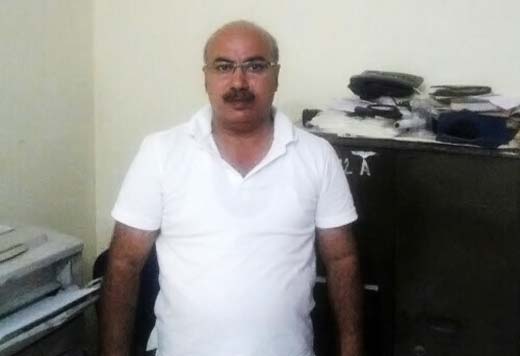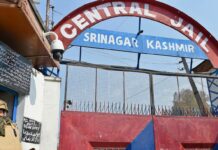It was Arun Sharma, a Jammu based journalist’s chance meeting with Sanaullah Ranjay, a Pakistani national killed in Kot Bhalwal jail Jammu, that started a chain of investigation revealing that the slain was already in custody when blasts he was accused of carrying out were happening. Bilal Handoo talks to the reporter whose investigation exposed the system of vengeance.

On Dec 02, Arun Sharma, a Jammu-based Indian Express correspondent unearthed the fact that Sanaullah Ranjay, the slain Pakistani prisoner in Kot Bhalwal jail, was serving sentence for attacks that took place while he was in custody.
Sharma’s investigative report revealed that the Pakistani national, who was killed by a fellow prisoner in a Jammu jail just days after the death of Indian national Sarabjit Singh in a similar attack in Lahore’s Kot Lakhpat jail in May this year, was undergoing life imprisonment for two terror attacks in 1994, the year when he was in police custody.
It took Sharma, 10 months to gather the information from the J&K Police and state prisons department.
“It all started in February this year when I went to cover musical event in Kot Bhalwal jail,” Arun Sharma, who works as an assistant editor with Indian Express told Kashmir Life. Sharma started his journalistic career with the daily Excelsior in 1984. And then worked for Reuters from 1989 to 1991, during which he covered the high profile Rubaya Syeed kidnapping case as well. In 1991, he joined Chandigarh bureau of Indian Express and since then is associated with the publication.
“During our interaction there, I and Ranjay talked about various things including his arrest. He told me that he was in jail for illegally crossing border and not for any militancy related activity.”
The revelation made by Ranjay about his arrest started fact-finding into his case. “From March this year till December, I kept pooling details involved in his case,” Sharma said.
And when the details emerged in the form of report, law enforcing agencies of state were left red-faced.
 “All these explosions, in which dozens of people were killed and injured, took place during the time Ranjay was still in police custody, awaiting deportation to Pakistan after completing a three-year sentence for crossing the border illegally in 1989,” the report prepared by Sharma noted. “According to the procedure in such cases, after serving sentence, the person has to be in police custody till the time he is deported. The deportation process can take up to months, or even years, as was the case with Ranjay.”
“All these explosions, in which dozens of people were killed and injured, took place during the time Ranjay was still in police custody, awaiting deportation to Pakistan after completing a three-year sentence for crossing the border illegally in 1989,” the report prepared by Sharma noted. “According to the procedure in such cases, after serving sentence, the person has to be in police custody till the time he is deported. The deportation process can take up to months, or even years, as was the case with Ranjay.”
In reply to an application filed by Arun Sharma on the behalf of The Indian Express under the Right to Information Act, asking when Sanaullah Ranjay, son of Rehmat Ali of Dalowali, was first arrested, police said they had not arrested any such person.
“But, they said, one Sanaullah, son of Ashiq Hussain of Dalowali in Sialkot, was arrested in 1996 on charges of illegally entering India from across the border in RS Pura area,” the report noted.
The prisons department, however, in reply to a separate RTI application filed by Sharma, admitted that Sanaullah, son of Rehmat Ali of Dalowali village in Sialkot, was lodged in its district jail at Ambphalla between 1989 and 1992. He was first brought there on September 9, 1989 as an under trial and after 45 days detained under the Public Safety Act (PSA) for two years on an order from the District Magistrate.
After completion of his two years detention under PSA on October 23, 1991, Ranjay continued to remain in jail for one more year to complete the three-year imprisonment awarded to him in the meantime by a court on charges of illegally crossing the border. “Further his lodgment is not traceable,” the prison department said in its reply.
That both the Sanaullahs — the one who spent three years in the district jail from 1989 and the other whom police claimed to have arrested first time only in 1996 — were the same was confirmed by Sanaullah Ranjay himself in a chance meeting with Arun Sharma during a music performance in Jammu’s high-security Kot Bhalwal prison in February, just months before his death.
Ranjay had told Sharma that after his release from the Ambphalla jail in 1992, he was taken to Kanachak police station for some months and then to a joint interrogation centre. Finally, he was again taken to RS Pura police station where he stayed for two years. In the meantime, militancy had spread to Jammu.
As his stay at the police station got prolonged and there appeared no immediate chances of his deportation, he said, police re-arrested him as a border-crosser in 1996 and sent him to jail where he spent nine months and nine days. He returned to RS Pura police station again and spent another two years waiting deportation until he got arrested by police on charges of carrying out 1994 bomb explosions.
About his involvement in the 1994 attacks, police had told the trial court that his name surfaced during questioning of one Karam Chand in another terror case registered at RS Pura police station in 1998.
Claiming that there used to be a bomb explosion in Jammu whenever Sanaullah crossed over to Indian side from Pakistan, Karam Chand had told police that he can identify him. On his identification, police picked up Sanaullah from the RS Pura police station where he was awaiting deportation.
Police told the trial court that Sanaullah confessed to carrying out 12 bomb explosions in Jammu city and on its outskirts including the one in a Matador which killed seven passengers and injured 16 people near Satwari on July 16, 1994. The charge sheet also included a blast that was planted inside a bus that killed 10 people and injured 43 others near Pir Baba shrine at Ramnagar on the Jammu-Srinagar national highway on November 28, 1994.















